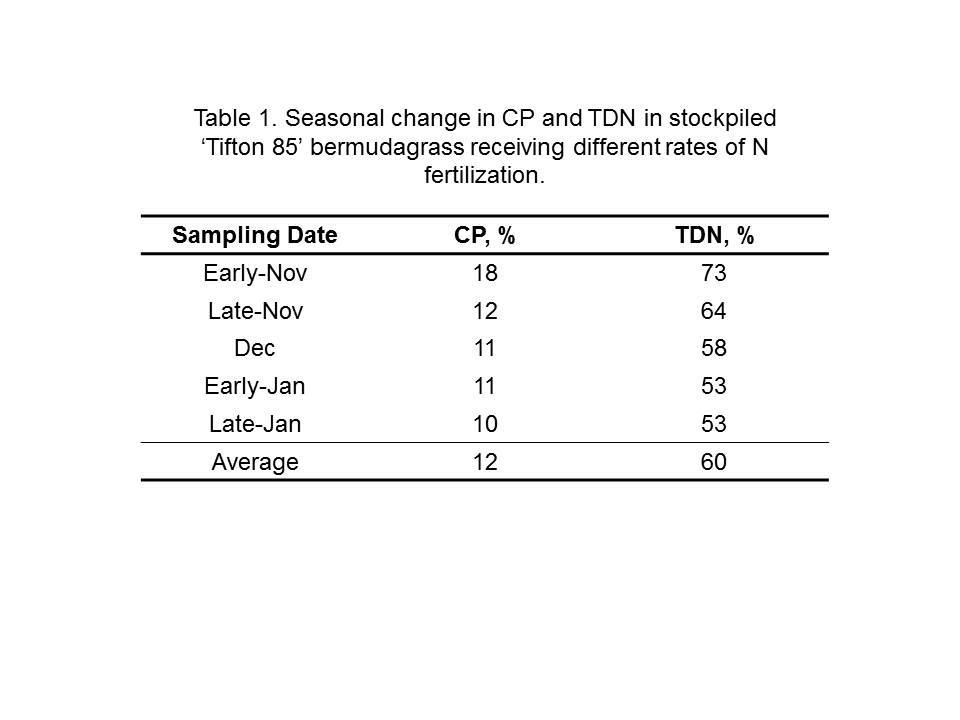Stockpiled Tifton 85 bermudagrass for lactating beef cows
Now is the time to start thinking about stockpiling forages for this fall. Stockpiling is a management practice in which forage is allowed to accumulate for grazing at a later time. This practice can provide a significant opportunity for reducing winter supplementation costs for the cow herd.
Research in the southeastern US has shown that stockpiled bermudagrass will often have adequate quality for maintaining dry, pregnant animals with little to no supplementation. However, the quality of stockpiled bermudagrass has been considered a limiting factor in supporting the production and performance of lactating beef cows. Studies at the University of Georgia have shown that when compared with ‘Coastal’ bermudagrass, ‘Tifton 85’ bermudagrass has greater forage accumulation and is considerably more digestible than older, less improved varieties, making it an excellent candidate for stockpiling. Given the high quality of Tifton 85 bermudagrass, a two-year study was recently conducted at the Auburn University Wiregrass Research and Extension Center in Headland, AL evaluating the use of stockpiled Tifton 85 for supporting lactating, fall-calving cow herds compared to feeding hay plus supplement during the fall-forage deficit.
Tifton 85 bermudagrass was mowed in early August of each year, and fertilized with either 50, 100, or 150 pounds (lb) of nitrogen per acre in mid- to late-August for stockpiling. Cow-calf pairs were allowed to graze stockpiled bermudagrass in late October/early November of each year until early February or were fed free-choice Tifton 85 bermudagrass hay + 6 lb of whole cottonseed per day. Pastures were managed using frontal grazing. Forage production, nutritional value, cow body condition score (BCS), and reproductive performance were measured and compared among the systems.
What did they find?
Forage Production
This research found that forage mass among the three fertilization rates was similar across the two-year evaluation period (average 4,500 lb dry matter per acre). This suggests that an application rate of 50 lbs of nitrogen per acre was sufficient in providing adequate forage mass for fall stockpiling in this region.
Forage Nutritive Value
Forage nutritive value was high throughout the study, and maintained an average of 60% total digestible nutrients (TDN) and 12% crude protein (CP). Change in quality was minimal across fertilization rates. The nutritional value of hay fed in the study was significantly lower in quality with 51% TDN and 10% CP. The change in nutritional value across the stockpiling period (TDN and CP) is shown in Table 1.

Cow performance
Cows grazing stockpiled Tifton 85 or fed hay plus 6 lb of whole cottonseed per day remained within the ideal BCS range of 5 and 6 throughout the study, and the overall rebreeding rate was 88%. An interesting point is that the second year of this study took place last winter during one of the coldest winters on record in recent years and the animals still remained in good condition. This suggests that stockpiled Tifton 85 bermudagrass may provide equivalent capacity to supplement lactating animals during the fall forage gap.
Economics
Grazing stockpiled Tifton 85 bermudagrass fertilized at 50, 100, and 150 lbs of N per acre reduced cow feeding costs by 66%, 61%, and 56%, respectively, when compared to the cost of feeding hay and supplement over the winter feeding period. Input costs on a per cow basis increased marginally with increasing rates of N application. The cost per cow for the hay plus supplement treatment was more than double the costs associated with grazing stockpiled Tifton 85 bermudagrass.

For more information on how to stockpile bermudagrass, check out www.alabamaforages.com or www.georgiaforages.com.
______________________________________________________________________________________
Prepared by Dr. Kim Mullenix, Extension Beef Cattle Systems Specialist, Courteney Holland, Graduate Research Assistant, Department of Animal Sciences, and Dr. Walt Prevatt, Extension Livestock Economist, Auburn University, AL

What numbers/prices are you using for hay (cost per bale, amount fed, wastage, etc.), “grazing cost”, and fixed costs? If 4 months of hay and protein supplement costs >$500 per cow, we are in trouble. I agree that stockpiling forages is much cheaper than feeding hay/supplementing but find it hard to believe it is twice as expensive.
The nitrogen input cost includes cost of ammonium nitrate. Grazing costs include the estimated cost of forage establishment and herbicides. Hay costs take into account the cost of harvesting, baling, feeding, and wastage on a per cow basis. There were 16 cows used in this study, and the total costs were estimated and spread across this number of animals to get these values.
What was the cost per bale and how long were you feeding (stockpiled vs. hay)?
The hay cost was estimated on a per ton basis ($132/ton). The feeding period was on average 100 days across both years of the study.